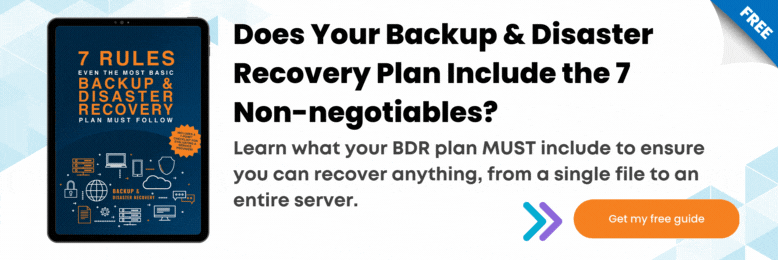Protect Your Business with a Disaster Recovery Plan
March 25th, 2022 | 3 min. read

Data is everything to a small business in this day and age, which means if you lose access or control of your data, you lose everything.
As dramatic as that might sound, studies and statistics back that up.
According to one study by the British Chambers of Commerce (BCC), 93% of companies, no matter how big they are, are out of business within one year if they suffer extended data loss for more than ten days; while fifty percent file for bankruptcy almost immediately.
This results from the lack of a disaster recovery plan in place. In the same report, they learned that 68% of businesses don’t have any sort of plan for that worst-case scenario. That only means one thing: losing data would be a death knell for most of the businesses in the country.
Fortunately, your business does not have to be one of them.
At ITS, we’ve encountered many cases of severe business data loss as a consequence of not having a suitable plan set up. So, we swear by helping businesses survive such disasters by building a reliable disaster recovery plan.
In this article, you will learn about all the factors that you must take into account when building a disaster recovery plan for your business.
What are the things to consider when building a disaster recovery plan?
No matter how hard we try to avoid it, data disasters will happen in the forms of:
- Human error
- File corruption
- Malware attacks
- Cloud synchronization
- External factors such as fire, hurricanes, and other natural disasters

As such, having a set disaster recovery plan is vital to be able to resume operations immediately and help lessen its aftermath.
By taking the following steps, you can guarantee that you have a working disaster recovery plan in times of trouble.
 Know How A Disaster Recovery Plan Is Different From A Business Continuity Plan
Know How A Disaster Recovery Plan Is Different From A Business Continuity Plan
The main difference between these two types of plans is that while business continuity plans are proactive, disaster recovery plans are reactive.
More specifically, a business continuity plan is a strategy by which a business ensures that it can continue to operate and provide products and services to its customers, no matter what disaster befalls it.
A disaster recovery plan, on the flip side, is a strategy by which businesses can back up and recover critical data should it get lost or held for ransom. Specifically, it is a virtual system connected to the main server that takes snapshots of your entire server and then keeps it in a safe place offsite.
So, now that you have a clear, concise understanding of what makes up a disaster recovery plan, we can dive into the steps necessary to create one.
 Gather Information And Support
Gather Information And Support
In order to get the ball rolling on your disaster recovery plan, start with executive buy-in.
This means that everyone, from the CEO to the entry-level employees, needs to be brought in on executing the plan. When everyone is aware of the possibility of a data disaster, it allows for cross-functional collaboration in the creation process–a necessary step if you want to prevent breaches in all parts of your systems.
You need to account for all elements in your tech systems when you’re putting together your disaster recovery plan, including:
- Systems
- Applications
- Business data
Be sure to put into consideration any issues involving the physical security of your servers as well as physical access to your systems. You’ll need a plan in case those are compromised.
In the end, you’ll need to figure out which processes are absolutely necessary to keep up and running during a worst-case scenario when your capacity is limited.
 Create Your Strategy
Create Your Strategy
When everyone is on board with the disaster recovery plan, and they understand their systems’ vulnerabilities, as well as which systems need to stay up and running even in a worst-case scenario, it’s time to actually put together the game plan.
In order to do that, you’ll need to have a good grip on your budget, resources, tools, and partners.
If you’re a small business, you might want to consider your budget and the timeline for the recovery process. These are good starting points for putting together your plan, and doing so will also give you an idea of what you can tell your customers to expect while you get your business back up to full operating capacity.
 Test The Plan
Test The Plan
Disaster recovery testing is crucial. Even if you complete the first two steps, you’ll never know that you’re prepared until you actually test out your disaster recovery plan.
Running through all the steps with your employees helps them familiarize themselves with the actions they’ll need to take in the event of a real emergency. In addition to that, it will help you detect any areas of your plan that need improvement. By the time an actual data disaster befalls your business, your systems and employees will easily know how to spring into action.
The recommended interval time between every test depends on your nature of business, but once a year is a good start. However, if possible, you may opt to implement it as often as you deem necessary.
Ready to build a reliable disaster recovery plan?
 We’ve covered a lot so, a recap might helpful to bear in mind the steps we’ve discussed. To review, these are the quick actions that you and your employees will need to take in order to make a successful, robust disaster recovery plan:
We’ve covered a lot so, a recap might helpful to bear in mind the steps we’ve discussed. To review, these are the quick actions that you and your employees will need to take in order to make a successful, robust disaster recovery plan:
- Get executive buy-in for the plan.
- Research and analyze the different systems in your business to understand how any changes could impact them.
- Prioritize systems that are absolutely necessary to the functioning of your business.
- Test your disaster recovery plan to evaluate its effectiveness.
Once you complete these steps, you can ensure that your business will survive any data disaster that comes your way.
For more extensive information about the design, implementation, and maintenance of a backup & disaster recovery plan, you may click and download the e-book link.
Jess is a Content Writer who commits herself to creating helpful, relevant, and easy-to-digest technical articles. When she isn't writing, she devotes her energy (and money) to collecting K-Pop photo cards, which she likes to call an 'investment.'
